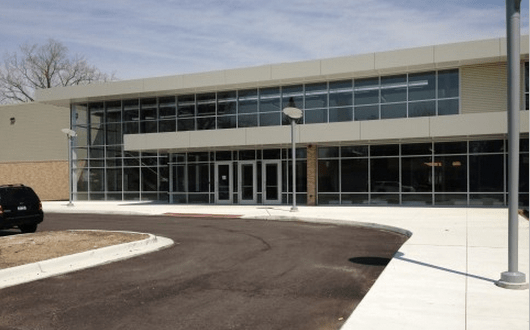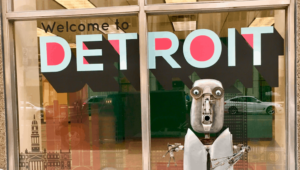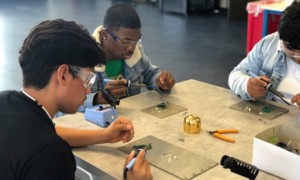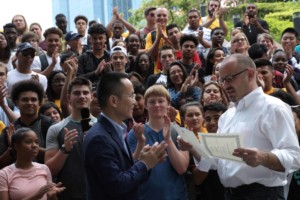Smart Cities: Detroit

Detroit is a man-made disaster–a once great city whose economy collapsed as a result of global forces and local mismanagement. Those that could fled the city–the population declined by 60% over the last 50 years. Enrollment in the state’s largest district dropped by more than 100,000 students in 10 years–more dramatic than New Orleans. The governor declared a fiscal emergency and took control of the city and school district in March 2013.
Blight and barren land where the two overwhelming observations made by a group of Washington D.C. teachers touring the sprawling city in a graffiti covered school bus last week. Parts of the city are post-apocalyptic–vacant homes next to vacant lots, abandoned warehouses, and boarded up retail–but often right across the street there are tidy homes and trimmed lawns and families exemplifying a popular t-shirt slogan, Detroit hustles harder.
Despite the odds, educational opportunity is on the rise. Armen Hratchian, Excellent Schools Detroit, notes that a group of 30 teachers and school leaders from across Michigan’s Education Achievement Authority (EAA), Cornerstone Charter Schools, Detroit Edison Public School Academy (DEPSA), Detroit Public Schools (DPS), and WAY Academies meet monthly, tour each others’ schools, and learn together. “In Detroit, where hyper-competition has led to educator isolation, this is a big breakthrough,” said Hratchian, “and even more important, one that’s happening around personalized learning.”
Disaster Recovery. Modeled after the successful Louisiana Recovery School District (RSD), Michigan created a statewide school improvement, the Education Achievement Authority (EAA), in 2011. The EAA started operating 15 Detroit schools in September 2012. In February, the EAA lost its exclusive status as the state’s only takeover strategy but won the right to operate up to 50 schools statewide.
While the Louisiana RSD has relied on chartering, the EAA continues to operate schools with only a few charters. Chancellor John Covington, building on work he started in Kansas City, is building a coherent system and a performance-based culture. They are building positive climates and supporting effective learning practices around 5 pillars:
- Students are grouped by readiness and progress via mastery not by age or seat time;
- Students master rigorous content aligned to international and state standards at their own pace;
- Students assume ownership for their learning and are able to communicate their progress;
- Students acquire knowledge through the teacher, tech, peers, and through their own research; and
- Students, parent and teachers receive continuous feedback
EAA benefited from a $10 million grant from the Broad Foundation. Nolan, one of 6 of the K-8 schools operated by the EAA, won an NGLC grant and the EAA received an NGLC planning grant for a new high school design. The school model and Buzz platform, built in partnership with Agilix. There are 8 things I really like about Buzz include student options in learning, practice, and demonstration; feedback, tracking, and pacing aids; and proficiency grading and performance grouping. Version 2.0 of Buzz is being rolled out across the EAA and is being made available to other schools.
All six of the EAA operated K-8 schools, all formerly among the worst in the state, have shown strong academic growth. The majority of students across the six high schools showed 2 or more years of growth–according to Scantron pre/post assessments. Special education students showed even stronger growth. Deputy Chancellor Mary Esselman said, “The kids get the system now–it will be like 2 extra months of school.” She added, “We are working hard on student voice.”
Pershing High School science teachers worked with Educurious to design their own digital problem-based learning units. Project Director Jane Chadsey said, “As a part of our design process we match the teachers up with experts in the disciplinary field of the unit they are creating. The experts support the teachers with the design and content work, including providing resources.” The units will be loaded into the updated version of Buzz and made available across the EAA.
Most EAA schools have not shown big gains on the fall state tests and there is a lot of grassroots and legislative resistance to the EAA. “When I look at the personalized learning schools in Detroit, I’m both encouraged by the student engagement but also concerned with the unevenness of results,” said Hratchian. In March actions, the EAA won the ability to expand to 50 schools but lost its exclusive relationship to serve low performing schools.
Things are getting better inside Detroit Public Schools (DPS) as well. A year after state takeover, the district was taken off High Risk status and gained some independence in its financial and administrative functions. A.L. Holmes Elementary is an example of a DPS school on the rise. After landing on the state’s priority list a few years back, they brought on a new principal, worked with Matchbook for a few years, and a good example of blended learning.
Teach for America was shut out of Detroit for years but two years ago they were invited back to the District, to EAA, and to charter schools in the city. The University of Michigan, in nearby Ann Arbor, sends more grads to TFA than any other school.
Led by turnaround expert Sajan George, a Matchbook Learning is another NGLC grant winner and EAA partner working with middle schools in Detroit. The conversion focuses on school culture, teacher coaching, stakeholder engagement, and blended classrooms. Students are “grouped into small and flexible groups based on student readiness, interests, learning style and profile, and specific instructional objectives.” Burns K-8 was the worst school in Michigan a couple years ago and recently made my list of 38 k-8 schools to visit after a year working with Matchbook.
David Esselman, now with GreatGains, was on EAA design team for the original structure. Esselman said, “Detroit is more interesting now than New Orleans after the storm.” He notes funding of $12,000 per student and “a whole range of incredibly strong communities.” It’s a place where, “a person with a new model and a good idea can attract talent,” says Esselman.
Charters. Over half of the schools in Detroit are charter schools with the nation’s second largest market share of 51% according to the National Alliance for Public Charter Schools. However, the ecosystem is chaotic with 32 separate authorizers and lots of small operators. Brand name CMOs are glaringly absent.
Natasha Baker is the Detroit Public Schools (DPS) Chief Innovation Officer and Kisha Verdusco is the director Charter Schools–and authorizer for a dozen schools. They replace Detroit charter veteran Doug Ross who did an 18 month stint at DPS. While there Ross set up Detroit Rising Prep Schools a semi-autonomous network of district schools. He runs up America Promise Schools, a nonprofit CMO that runs the Jalen Rose Leadership Academy.
Henry Ford Academy, opened in 1997 in the Henry Ford Museum, is a great example of a museum-based STEM school. With support from Ford Motor Company and the Bill & Melinda Gates Foundation, the The Henry Ford Learning Institute, supported four new schools in Detroit, Chicago, and San Antonio. This model partnership combines the best thinking from business, non-profit, and public education toward the common goal of building a school that prepares students for life in the 21st century. Design thinking and “new ways of doing school” are influenced by long-time relationship with IDEO and Stanford d.school.
Cornerstone Charter School (pictured) opened two new blended charters this school year, an elementary (which opened K-4) and a high school (starting with ninth graders). CEO Tom Willis said, “This is our first blended high school, but we have a 20-year record of delivering high-quality Detroit schools. We have two existing charter schools serving 1,000 students.” They also run the top performing independent primary school.
“We’ve had some wonderful partners,” said Willis, “These include Grand Valley State University and The Detroit Medical Center. As noted last year, Cornerstone uses content from Compass Learning, Dreambox, Apex, and Achieve 3000. To progress, students must show mastery on a variety of assessments. Progress is noted on dashboards and reviewed weekly with a Relationship Manager. Differentiated roles also include Rigor Managers and Relevance Managers. The ‘beginner level’ (9th grade) opened last fall as a flex model supplemented by workshops, but to improve pacing and support they moved back to three days of cohort-based classroom work and two days of computer lab.
Cornerstone Charter Health High School, which recently gained access to a permanent facility, has a close partnership with the Detroit Medical Center. “Throughout their academic experience, students are encouraged to explore health- related careers and competencies through projects, coursework, and internships.” said Willis.
Advocates. In addition to state intervention, local advocates are taking their schools back. A coalition group, Excellent Schools Detroit, is funded by Kellogg, Kresge, Skillman, McGregor, and United Way. The agenda includes public will building, talent development, new school creation, accountability, and early childhood development. VP Armen Hratchian said, “We look for gaps in the ecosystem, work with partners to build solutions, and move on.” On will building, they issue report cards on all schools in Detroit. On the talent front, they worked with University of Michigan-Flint on a residency model (to complement TFA) and collaborate with Leading Educators in NOLA.
Jason Weeby, the Senior Director of New Initiatives at Education Pioneers, Michigan native, and long-time observer of education reform efforts in Detroit sees Excellent Schools Detroit as a lynchpin organization that could have a similar impact as leading CEE-Trust member ‘harbormasters.’ “Excellent Schools Detroit holds tremendous potential as a harbormaster but could be much more aggressive in creating a vision for the future, influencing Detroit’s diverse school portfolio, and building a thriving nonprofit ecosystem. Tackling high-leverage issues that plague the city like poor operators and authorizers, the dearth of nationally renown CMOs and nonprofits, and attracting talent are necessities. There’s a long list of top-notch leaders and organizations interested in Detroit but they need ESD to lower the risk and make the opportunity compelling.”
Potential for Innovation. Weeby would like to see more high-impact organizations put Detroit at the top of their expansion list. “More than any other city in the US, Detroit has optimal conditions for ambitious education organizations that can balance a strong moral imperative with their business decisions. The dire circumstances mean there’s motivated stakeholders; the city has a strong, focused philanthropic community; there’s a broader entrepreneurial movement in the city that can be tapped.”
While mayoral control can be a constructive path for some cities, Detroit is a sobering reminder of why there is no one solution for advancing the much-needed reform of American public education. “Despite all the innovation,” according to Armen Hratchian, “we still have far too many failing schools and too complicated of a marketplace for most parents to navigate. High on our agenda is to stop the expansion of low performing authorizers and operators.” Hratchian would like to see better parent information, a common application (like NOLA OneApp), and improved transportation.
The Digital Learning Now Report Card gave Michigan a C- owing to weak access to online learning and barriers to competency-based learning.
As RiShawn Biddle notes, it’s time to move beyond the traditional urban district model to a portfolio of options. Like New Orleans, Detroit could emerge as a model of rapid progress powered by multiple operators–with a blended twist. Mary Esselman summed it up, “There’s no place with so many kids transitioning so quickly to a blended model. It’s the largest blended learning case study out there”.
Thanks to Jason Weeby and Armen Hratchian for help updating this post. Thanks to CityBridge Foundation for sponsoring a trip to Detroit last week.
Compass Learning and Dreambox Learning are Advocacy Partners.







Leslie Wilson
This is a great overview of the progress and complexities of authentic reform. Tom, you nailed it when you noted that it takes numerous pathways, partners and focus areas to really get to the needed changes. There are no silver bullets or quick fixes. It's hard work and takes many committed individuals and organizations to persevere. Thanks.
Michael Clifford
Nice work!